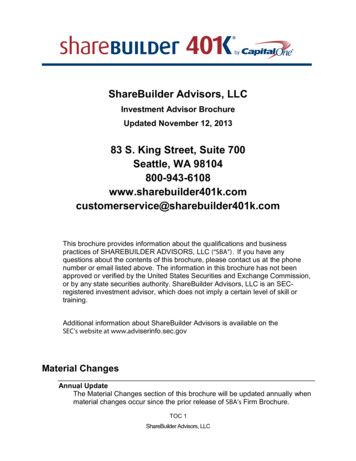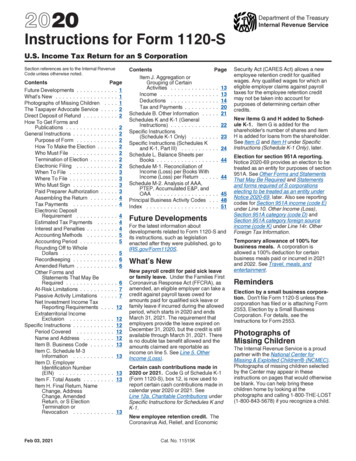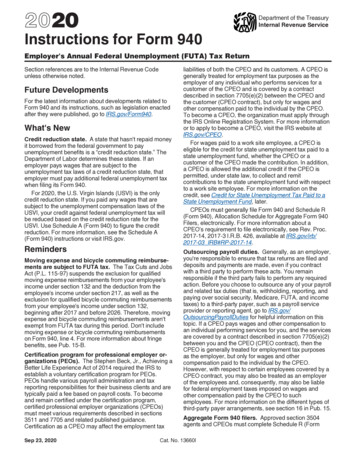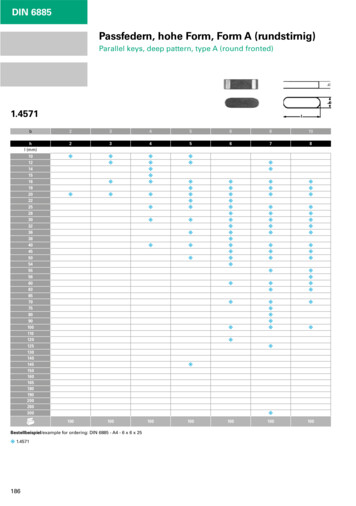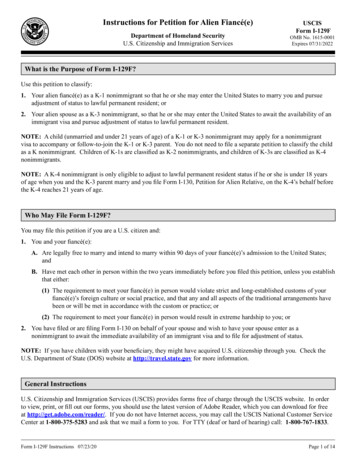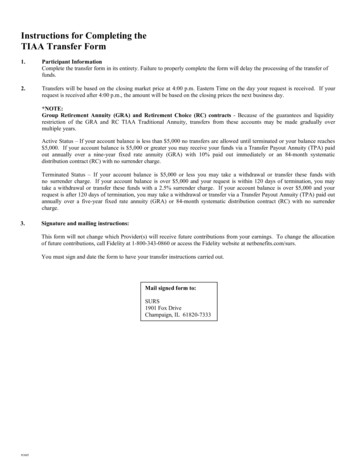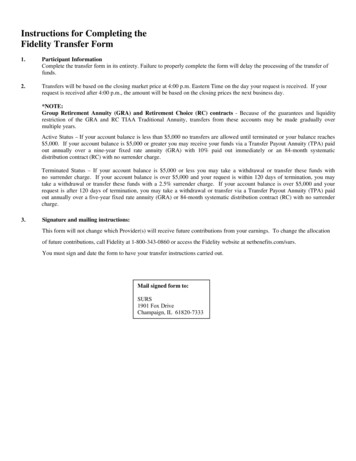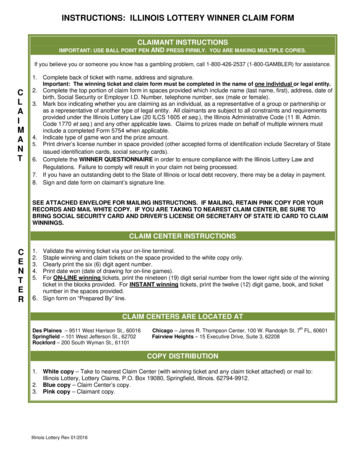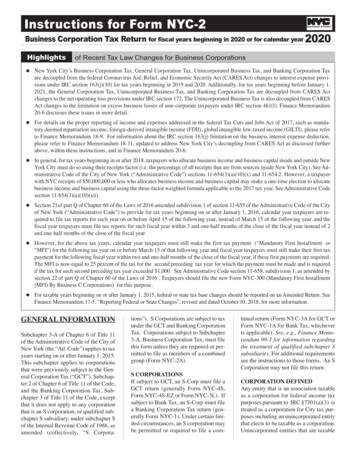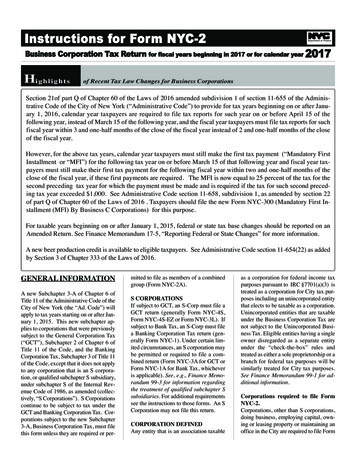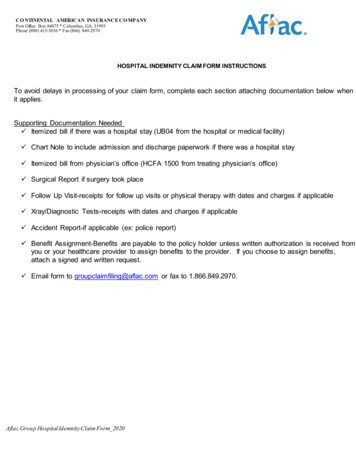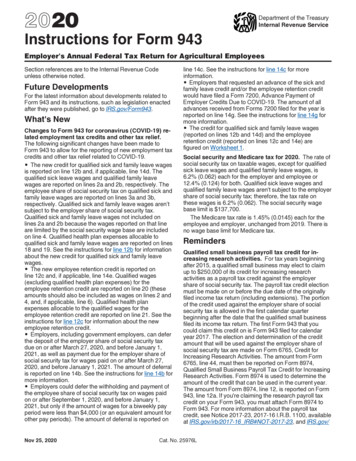
Transcription
2020Instructions for Form 943Department of the TreasuryInternal Revenue ServiceEmployer's Annual Federal Tax Return for Agricultural EmployeesSection references are to the Internal Revenue Codeunless otherwise noted.Future DevelopmentsFor the latest information about developments related toForm 943 and its instructions, such as legislation enactedafter they were published, go to IRS.gov/Form943.What's NewChanges to Form 943 for coronavirus (COVID-19) related employment tax credits and other tax relief.The following significant changes have been made toForm 943 to allow for the reporting of new employment taxcredits and other tax relief related to COVID-19. The new credit for qualified sick and family leave wagesis reported on line 12b and, if applicable, line 14d. Thequalified sick leave wages and qualified family leavewages are reported on lines 2a and 2b, respectively. Theemployee share of social security tax on qualified sick andfamily leave wages are reported on lines 3a and 3b,respectively. Qualified sick and family leave wages aren’tsubject to the employer share of social security tax.Qualified sick and family leave wages not included onlines 2a and 2b because the wages reported on that lineare limited by the social security wage base are includedon line 4. Qualified health plan expenses allocable toqualified sick and family leave wages are reported on lines18 and 19. See the instructions for line 12b for informationabout the new credit for qualified sick and family leavewages. The new employee retention credit is reported online 12c and, if applicable, line 14e. Qualified wages(excluding qualified health plan expenses) for theemployee retention credit are reported on line 20 (theseamounts should also be included as wages on lines 2 and4, and, if applicable, line 6). Qualified health planexpenses allocable to the qualified wages for theemployee retention credit are reported on line 21. See theinstructions for line 12c for information about the newemployee retention credit. Employers, including government employers, can deferthe deposit of the employer share of social security taxdue on or after March 27, 2020, and before January 1,2021, as well as payment due for the employer share ofsocial security tax for wages paid on or after March 27,2020, and before January 1, 2021. The amount of deferralis reported on line 14b. See the instructions for line 14b formore information. Employers could defer the withholding and payment ofthe employee share of social security tax on wages paidon or after September 1, 2020, and before January 1,2021, but only if the amount of wages for a biweekly payperiod were less than 4,000 (or an equivalent amount forother pay periods). The amount of deferral is reported onNov 25, 2020line 14c. See the instructions for line 14c for moreinformation. Employers that requested an advance of the sick andfamily leave credit and/or the employee retention creditwould have filed a Form 7200, Advance Payment ofEmployer Credits Due to COVID-19. The amount of alladvances received from Forms 7200 filed for the year isreported on line 14g. See the instructions for line 14g formore information. The credit for qualified sick and family leave wages(reported on lines 12b and 14d) and the employeeretention credit (reported on lines 12c and 14e) arefigured on Worksheet 1.Social security and Medicare tax for 2020. The rate ofsocial security tax on taxable wages, except for qualifiedsick leave wages and qualified family leave wages, is6.2% (0.062) each for the employer and employee or12.4% (0.124) for both. Qualified sick leave wages andqualified family leave wages aren't subject to the employershare of social security tax; therefore, the tax rate onthese wages is 6.2% (0.062). The social security wagebase limit is 137,700.The Medicare tax rate is 1.45% (0.0145) each for theemployee and employer, unchanged from 2019. There isno wage base limit for Medicare tax.RemindersQualified small business payroll tax credit for increasing research activities. For tax years beginningafter 2015, a qualified small business may elect to claimup to 250,000 of its credit for increasing researchactivities as a payroll tax credit against the employershare of social security tax. The payroll tax credit electionmust be made on or before the due date of the originallyfiled income tax return (including extensions). The portionof the credit used against the employer share of socialsecurity tax is allowed in the first calendar quarterbeginning after the date that the qualified small businessfiled its income tax return. The first Form 943 that youcould claim this credit on is Form 943 filed for calendaryear 2017. The election and determination of the creditamount that will be used against the employer share ofsocial security tax are made on Form 6765, Credit forIncreasing Research Activities. The amount from Form6765, line 44, must then be reported on Form 8974,Qualified Small Business Payroll Tax Credit for IncreasingResearch Activities. Form 8974 is used to determine theamount of the credit that can be used in the current year.The amount from Form 8974, line 12, is reported on Form943, line 12a. If you're claiming the research payroll taxcredit on your Form 943, you must attach Form 8974 toForm 943. For more information about the payroll taxcredit, see Notice 2017-23, 2017-16 I.R.B. 1100, availableat IRS.gov/irb/2017-16 IRB#NOT-2017-23, and IRS.gov/Cat. No. 25976L
ResearchPayrollTC. Also see Adjusting tax liability fornonrefundable credits claimed on lines 12a, 12b, and 12c,later.Aggregate Form 943 filers. Approved section 3504agents and CPEOs must complete and file Schedule R(Form 943) when filing an aggregate Form 943. AggregateForms 943 are filed by agents approved by the IRS undersection 3504. To request approval to act as an agent foran employer, the agent files Form 2678 with the IRSunless you're a state or local government agency actingas an agent under the special procedures provided inRev. Proc. 2013-39, 2013-52 I.R.B. 830, available atIRS.gov/irb/2013-52 IRB#RP-2013-39. Aggregate Forms943 are also filed by CPEOs approved by the IRS undersection 7705. To become a CPEO, the organization mustapply through the IRS Online Registration System atIRS.gov/CPEO. CPEOs file Form 8973, CertifiedProfessional Employer Organization/Customer ReportingAgreement, to notify the IRS that they started or ended aservice contract with a customer. CPEOs must generallyfile Form 943 and Schedule R (Form 943) electronically.However, CPEOs are permitted to file a paper Form 943and its accompanying schedules in lieu of electronicsubmissions for the calendar year 2020. For moreinformation about a CPEO’s requirement to fileelectronically, and the waiver for 2020, see Rev. Proc.2017-14, 2017-3 I.R.B. 426, available at IRS.gov/irb/2017-03 IRB#RP-2017-14, and Notice 2020-35, 2020-25I.R.B. 948, available at IRS.gov/irb/2020-25 IRB#NOT-2020-35. For more information abouta CPEO's requirement to file electronically, seeRegulations section 31.3511-1(g)(2). Schedule R (Form943) has been revised for 2020 to allow for reporting ofthe new lines added to Form 943.Other third-party payers that file aggregate Forms 943,such as non-certified PEOs, must complete and fileSchedule R (Form 943) if they have clients that areclaiming the qualified small business payroll tax credit forincreasing research activities, the credit for qualified sickand family leave wages, or the employee retention credit,or clients deferring the employer or employee share ofsocial security tax.Certification program for professional employer organizations (PEOs). The Stephen Beck Jr., Achieving aBetter Life Experience Act of 2014 required the IRS toestablish a voluntary certification program for PEOs.PEOs handle various payroll administration and taxreporting responsibilities for their business clients and aretypically paid a fee based on payroll costs. To becomeand remain certified under the certification program,certified professional employer organizations (CPEOs)must meet various requirements described in sections3511 and 7705 and related published guidance.Certification as a CPEO may affect the employment taxliabilities of both the CPEO and its customers. A CPEO isgenerally treated for employment tax purposes as theemployer of any individual who performs services for acustomer of the CPEO and is covered by a contractdescribed in section 7705(e)(2) between the CPEO andthe customer (CPEO contract), but only for wages andother compensation paid to the individual by the CPEO.To become a CPEO, the organization must apply throughthe IRS Online Registration System. For more informationor to apply to become a CPEO, go to IRS.gov/CPEO.CPEOs must generally file Form 943 and Schedule R(Form 943), Allocation Schedule for Aggregate Form 943Filers, electronically. However, CPEOs are permitted tofile a paper Form 943 and its accompanying schedules inlieu of electronic submissions for calendar year 2020. Formore information about a CPEO's requirement to fileelectronically, and the waiver for 2020, see Rev. Proc.2017-14, 2017-3 I.R.B. 426, available at IRS.gov/irb/2017-03 IRB#RP-2017-14, and Notice 2020-35, 2020-25I.R.B. 948, available at IRS.gov/irb/2020-25 IRB#NOT-2020-35.Outsourcing payroll duties. Generally, as an employer,you’re responsible to ensure that tax returns are filed anddeposits and payments are made, even if you contractwith a third party to perform these acts. You remainresponsible if the third party fails to perform any requiredaction. Before you choose to outsource any of your payrolland related tax duties (that is, withholding, reporting, andpaying over social security, Medicare, FUTA, and incometaxes) to a third-party payer, such as a payroll serviceprovider or reporting agent, go to IRS.gov/OutsourcingPayrollDuties for helpful information on thistopic. If a CPEO pays wages and other compensation toan individual performing services for you, and the servicesare covered by a contract described in section 7705(e)(2)between you and the CPEO (CPEO contract), then theCPEO is generally treated for employment tax purposesas the employer, but only for wages and othercompensation paid to the individual by the CPEO.However, with respect to certain employees covered by aCPEO contract, you may also be treated as an employerof the employees and, consequently, may also be liablefor federal employment taxes imposed on wages andother compensation paid by the CPEO to suchemployees. For more information on the different types ofthird-party payer arrangements, see section 16 of Pub. 15.If both an employer and a section 3504 authorizedTIP agent (or CPEO or other third-party payer) paidwages to an employee during the year, both theemployer and the section 3504 authorized agent (orCPEO or other third-party payer, if applicable) should fileForm 943 reporting the wages each entity paid to theemployee during the year and issue Forms W-2 reportingthe wages each entity paid to the employee during theyear.If a third-party payer of sick pay is also paying qualifiedsick leave wages on behalf of an employer, the third partywould be making the payments as an agent of theemployer. The employer is required to do the reportingand payment of employment taxes with respect to thequalified sick leave wages and claim the credit for thequalified sick leave wages, unless the employer has anagency agreement with the third-party payer that requiresthe third-party payer to do the collecting, reporting, and/orpaying or depositing employment taxes on the qualifiedsick leave wages. If the employer has an agencyagreement with the third-party payer, the third-party payerincludes the qualified sick leave wages on the third party'saggregate Form 943, claims the sick leave credit on-2-Instructions for Form 943 (2020)
may charge you a fee for payments made this way. Tolearn more about the information you will need to giveyour financial institution to make a same-day wirepayment, go to IRS.gov/SameDayWire.Timeliness of federal tax deposits. If a deposit isrequired to be made on a day that isn't a business day, thedeposit is considered timely if it is made by the close ofthe next business day. A business day is any day otherthan a Saturday, Sunday, or legal holiday. The term “legalholiday” for deposit purposes includes only those legalholidays in the District of Columbia. Legal holidays in theDistrict of Columbia are provided in section 7 of Pub. 51.behalf of the employer on the aggregate Form 943, andseparately reports the credit allocable to the employers onSchedule R (Form 943). See section 6 of Pub. 15-A,Employer's Supplemental Tax Guide, for more informationabout sick pay reporting.Work opportunity tax credit for qualified tax-exemptorganizations hiring qualified veterans. Qualifiedtax-exempt organizations that hire eligible unemployedveterans may be able to claim the work opportunity taxcredit against their payroll tax liability using Form 5884-C.For more information, go to IRS.gov/WOTC.Correcting a previously filed Form 943. If youdiscover an error on a previously filed Form 943, make thecorrection using Form 943-X. Form 943-X is filedseparately from Form 943. For more information, see theInstructions for Form 943-X, section 9 of Pub. 51, or go toIRS.gov/CorrectingEmploymentTaxes.Electronic filing and payment. Businesses can enjoythe benefits of filing tax returns and paying their federaltaxes electronically. Whether you rely on a taxprofessional or handle your own taxes, the IRS offers youconvenient programs to make filing and paying easier.Spend less time worrying about taxes and more timerunning your business. Use e-file and EFTPS to yourbenefit. For e-file, go to IRS.gov/EmploymentEfile for additionalinformation. A fee may be charged to file electronically. For EFTPS, go to EFTPS.gov or call EFTPS at one ofthe numbers provided under Federal tax deposits must bemade by electronic funds transfer (EFT), earlier. For electronic filing of Forms W-2, Wage and TaxStatement, go to SSA.gov/employer. You may be requiredto file Forms W-2 electronically. For details, see theGeneral Instructions for Forms W-2 and W-3.If you change your business name, business address, or responsible party. Notify the IRSimmediately if you change your business name, businessaddress, or responsible party. Write to the IRS office where you file your returns (usingthe Without a payment address under Where To File,later) to notify the IRS of any business name change. SeePub. 1635 to see if you need to apply for a new employeridentification number (EIN). Complete and mail Form 8822-B to notify the IRS of abusiness address or responsible party change. Don't mailForm 8822-B with your Form 943. For a definition of“responsible party,” see the Instructions for Form SS-4.If you're filing your tax return or paying yourfederal taxes electronically, a valid EIN is requiredCAUTION at the time the return is filed or the payment ismade. If a valid EIN isn't provided, the return or paymentwon't be processed. This may result in penalties. SeeEmployer Identification Number (EIN), Name, TradeName, and Address, later, for more information aboutapplying for an EIN.!Federal tax deposits must be made by electronicfunds transfer (EFT). You must use EFT to make allfederal tax deposits. Generally, an EFT is made using theElectronic Federal Tax Payment System (EFTPS). If youdon't want to use EFTPS, you can arrange for your taxprofessional, financial institution, payroll service, or othertrusted third party to make electronic deposits on yourbehalf. Also, you may arrange for your financial institutionto initiate a same-day wire payment on your behalf.EFTPS is a free service provided by the Department of theTreasury. Services provided by your tax professional,financial institution, payroll service, or other third partymay have a fee.For more information on making federal tax deposits,see section 7 of Pub. 51. To get more information aboutEFTPS or to enroll in EFTPS, go to EFTPS.gov, or call800-555-4477 or 800-733-4829 (TDD). Additionalinformation about EFTPS is also available in Pub. 966.!CAUTIONElectronic funds withdrawal (EFW). If you file Form943 electronically, you can e-file and use EFW to pay thebalance due in a single step using tax preparationsoftware or through a tax professional. However, don't useEFW to make federal tax deposits. For more informationon paying your taxes using EFW, go to IRS.gov/EFW.Credit or debit card payments. You can pay thebalance due shown on Form 943 by credit or debit card.Your payment will be processed by a payment processorwho will charge a processing fee. Don't use a credit ordebit card to make federal tax deposits. For moreinformation on paying your taxes with a credit or debitcard, go to IRS.gov/PayByCard.For an EFTPS deposit to be on time, you mustsubmit the deposit by 8 p.m. Eastern time the daybefore the date the deposit is due.Online payment agreement. You may be eligible toapply for an installment agreement online if you can't paythe full amount of tax you owe when you file your return.For more information, see What if you can't pay in full,later.Same-day wire payment option. If you fail to submit adeposit transaction on EFTPS by 8 p.m. Eastern time theday before the date a deposit is due, you can still makeyour deposit on time by using the Federal Tax CollectionService (FTCS) to make a same-day wire payment. Touse the same-day wire payment method, you will need tomake arrangements with your financial institution ahead oftime. Please check with your financial institution regardingavailability, deadlines, and costs. Your financial institutionInstructions for Form 943 (2020)Paid preparers. If you use a paid preparer to completeForm 943, the paid preparer must complete and sign thepaid preparer's section of the form.Disregarded entities and qualified subchapter S subsidiaries (QSubs). Eligible single-owner disregarded-3-
File Schedule H (Form 1040) with your Form 1040 or1040-SR, or Include the wages with your farm employees' wages onForm 943.entities and QSubs are treated as separate entities foremployment tax purposes. Eligible single-member entitiesthat haven't elected to be taxed as corporations mustreport and pay employment taxes on wages paid to theiremployees using the entities' own names and EINs. SeeRegulations sections 1.1361-4(a)(7) and 301.7701-2(c)(2)(iv).If you paid wages to other nonfarm workers, don'treport these on Form 943. Taxes on wages paid tononfarm workers are reported on Form 941 or 941-SS,Employer's QUARTERLY Federal Tax Return, or Form944, Employer's ANNUAL Federal Tax Return. See Pub.926 for more information about household employees.Social security wage base for 2021. The maximumamount of wages subject to the social security tax for2021 will be discussed in the 2021 revision of Pub. 51.Telephone help. You can call the IRS Business andSpecialty Tax Line toll free at 800-829-4933 or800-829-4059 (TDD/TTY for persons who are deaf, hardof hearing, or have a speech disability), Monday–Fridayfrom 7:00 a.m. to 7:00 p.m. local time (Alaska and Hawaiifollow Pacific time), for answers to your questions aboutcompleting Form 943 and tax deposit rules.Who Must FilePhotographs of Missing ChildrenAfter you file your first Form 943, you must file a returnfor each year, even if you have no taxes to report, untilyou file a final return. You’re encouraged to file Form 943electronically. Go to IRS.gov/EmploymentEfile for moreinformation on electronic filing.File Form 943 if you paid wages to one or morefarmworkers and the wages were subject to socialsecurity and Medicare taxes or federal income taxwithholding under the tests discussed next. For moreinformation on farmworkers and wages, see Pub. 51.The IRS is a proud partner with the National Center forMissing & Exploited Children (NCMEC). Photographs ofmissing children selected by the Center may appear ininstructions on pages that would otherwise be blank. Youcan h
the IRS Online Registration System. For more information or to apply to become a CPEO, go to IRS.gov/CPEO. CPEOs must generally file Form 943 and Schedule R (Form 943), Allocation Schedule for Aggregate Form 943 Filers, electronically. However, CPEOs are permitted t
